In-depth Analysis of Sainsbury's Business and Environment Report
VerifiedAdded on 2020/01/07
|19
|4864
|295
Report
AI Summary
This report provides a comprehensive analysis of Sainsbury's, a major UK retailer, examining its organizational culture, structure, and functions. It delves into the interrelationships between these elements and their impact on the company's objectives. The report critically assesses Sainsbury's by evaluating the implications of macro and micro factors, including economic, political, social, and technological influences. It includes PESTLE and SWOT analyses to identify strengths, weaknesses, opportunities, and threats, along with an evaluation of these analyses. The report concludes with a reflective statement and recommendations based on the findings, offering insights into Sainsbury's market position, strategic challenges, and potential for improvement within the competitive retail landscape. The report also examines the company's objectives, which includes being a leader in the provision of high-quality goods and services while operating with integrity, and the various functions of the company that help achieve the company's objectives.
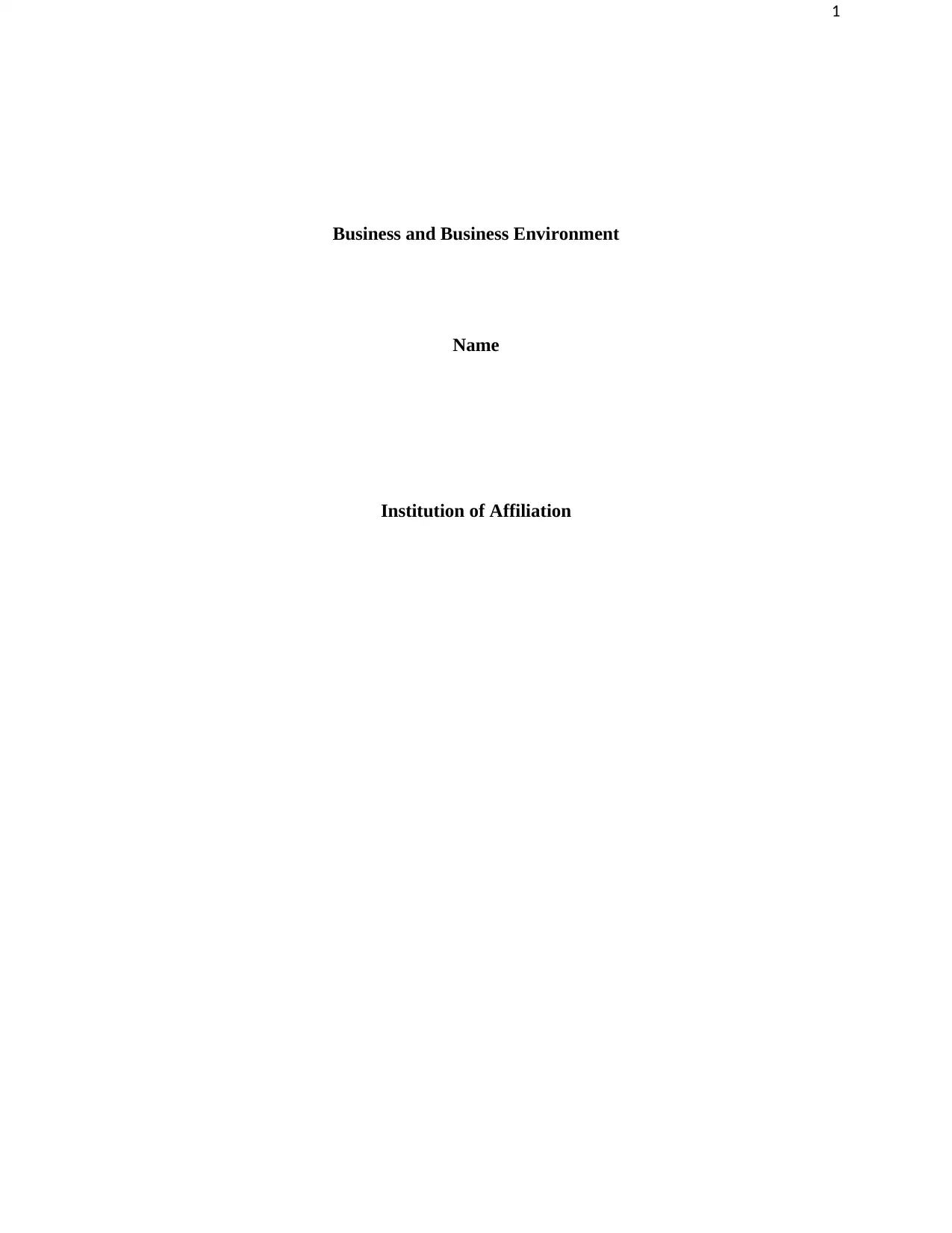
1
Business and Business Environment
Name
Institution of Affiliation
Business and Business Environment
Name
Institution of Affiliation
Paraphrase This Document
Need a fresh take? Get an instant paraphrase of this document with our AI Paraphraser
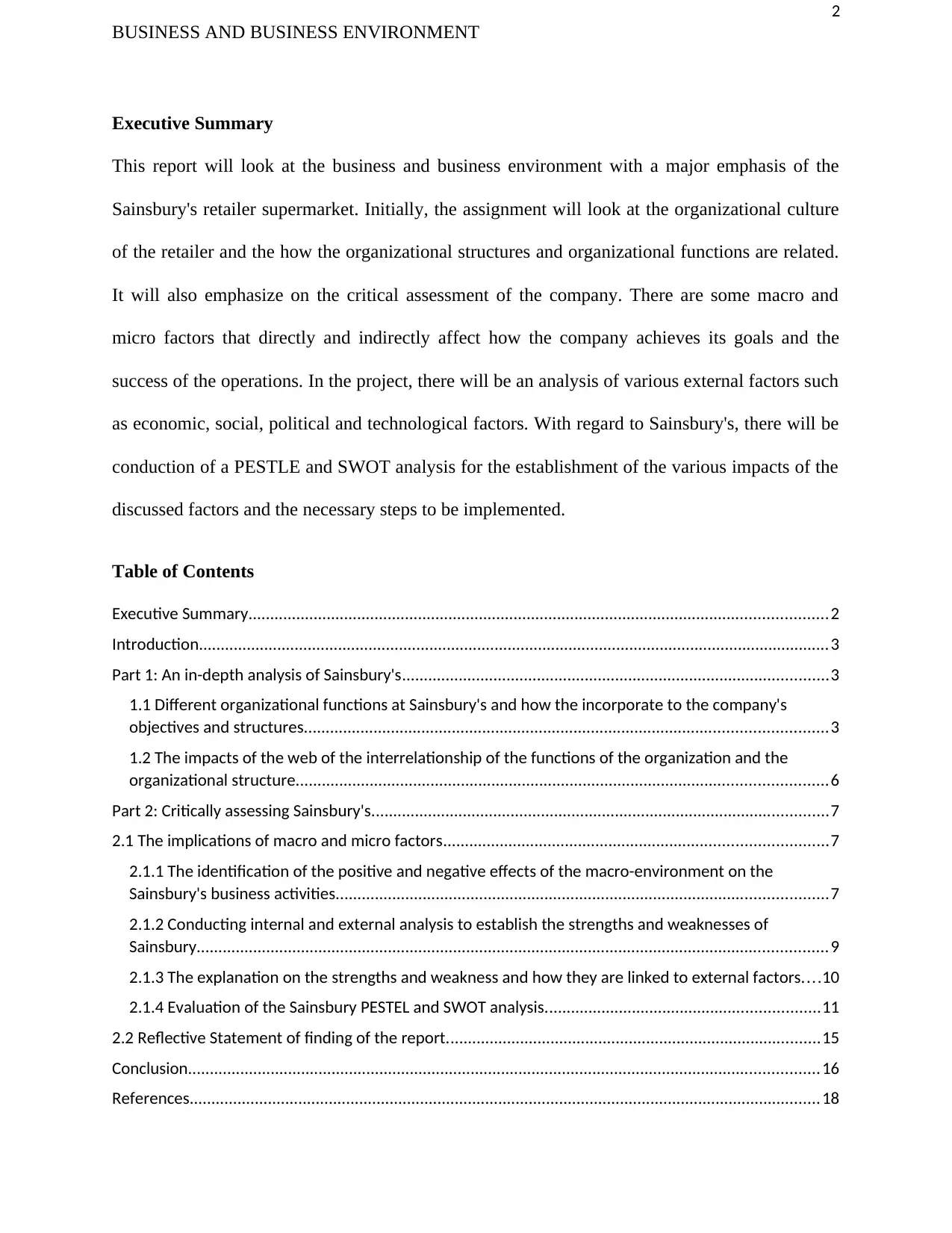
2
BUSINESS AND BUSINESS ENVIRONMENT
Executive Summary
This report will look at the business and business environment with a major emphasis of the
Sainsbury's retailer supermarket. Initially, the assignment will look at the organizational culture
of the retailer and the how the organizational structures and organizational functions are related.
It will also emphasize on the critical assessment of the company. There are some macro and
micro factors that directly and indirectly affect how the company achieves its goals and the
success of the operations. In the project, there will be an analysis of various external factors such
as economic, social, political and technological factors. With regard to Sainsbury's, there will be
conduction of a PESTLE and SWOT analysis for the establishment of the various impacts of the
discussed factors and the necessary steps to be implemented.
Table of Contents
Executive Summary.....................................................................................................................................2
Introduction.................................................................................................................................................3
Part 1: An in-depth analysis of Sainsbury's..................................................................................................3
1.1 Different organizational functions at Sainsbury's and how the incorporate to the company's
objectives and structures........................................................................................................................3
1.2 The impacts of the web of the interrelationship of the functions of the organization and the
organizational structure..........................................................................................................................6
Part 2: Critically assessing Sainsbury's.........................................................................................................7
2.1 The implications of macro and micro factors........................................................................................7
2.1.1 The identification of the positive and negative effects of the macro-environment on the
Sainsbury's business activities.................................................................................................................7
2.1.2 Conducting internal and external analysis to establish the strengths and weaknesses of
Sainsbury.................................................................................................................................................9
2.1.3 The explanation on the strengths and weakness and how they are linked to external factors....10
2.1.4 Evaluation of the Sainsbury PESTEL and SWOT analysis...............................................................11
2.2 Reflective Statement of finding of the report......................................................................................15
Conclusion.................................................................................................................................................16
References.................................................................................................................................................18
BUSINESS AND BUSINESS ENVIRONMENT
Executive Summary
This report will look at the business and business environment with a major emphasis of the
Sainsbury's retailer supermarket. Initially, the assignment will look at the organizational culture
of the retailer and the how the organizational structures and organizational functions are related.
It will also emphasize on the critical assessment of the company. There are some macro and
micro factors that directly and indirectly affect how the company achieves its goals and the
success of the operations. In the project, there will be an analysis of various external factors such
as economic, social, political and technological factors. With regard to Sainsbury's, there will be
conduction of a PESTLE and SWOT analysis for the establishment of the various impacts of the
discussed factors and the necessary steps to be implemented.
Table of Contents
Executive Summary.....................................................................................................................................2
Introduction.................................................................................................................................................3
Part 1: An in-depth analysis of Sainsbury's..................................................................................................3
1.1 Different organizational functions at Sainsbury's and how the incorporate to the company's
objectives and structures........................................................................................................................3
1.2 The impacts of the web of the interrelationship of the functions of the organization and the
organizational structure..........................................................................................................................6
Part 2: Critically assessing Sainsbury's.........................................................................................................7
2.1 The implications of macro and micro factors........................................................................................7
2.1.1 The identification of the positive and negative effects of the macro-environment on the
Sainsbury's business activities.................................................................................................................7
2.1.2 Conducting internal and external analysis to establish the strengths and weaknesses of
Sainsbury.................................................................................................................................................9
2.1.3 The explanation on the strengths and weakness and how they are linked to external factors....10
2.1.4 Evaluation of the Sainsbury PESTEL and SWOT analysis...............................................................11
2.2 Reflective Statement of finding of the report......................................................................................15
Conclusion.................................................................................................................................................16
References.................................................................................................................................................18
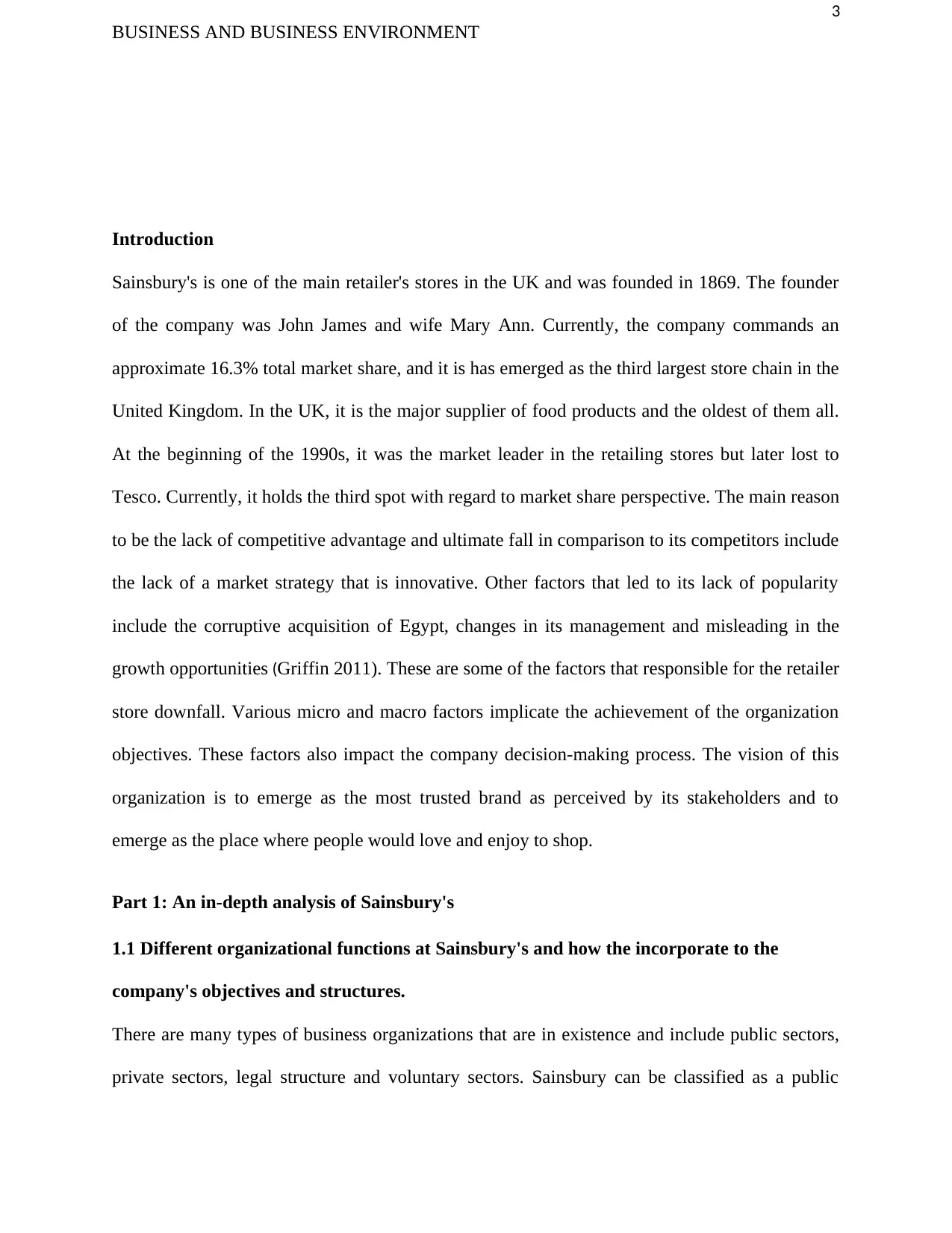
3
BUSINESS AND BUSINESS ENVIRONMENT
Introduction
Sainsbury's is one of the main retailer's stores in the UK and was founded in 1869. The founder
of the company was John James and wife Mary Ann. Currently, the company commands an
approximate 16.3% total market share, and it is has emerged as the third largest store chain in the
United Kingdom. In the UK, it is the major supplier of food products and the oldest of them all.
At the beginning of the 1990s, it was the market leader in the retailing stores but later lost to
Tesco. Currently, it holds the third spot with regard to market share perspective. The main reason
to be the lack of competitive advantage and ultimate fall in comparison to its competitors include
the lack of a market strategy that is innovative. Other factors that led to its lack of popularity
include the corruptive acquisition of Egypt, changes in its management and misleading in the
growth opportunities (Griffin 2011). These are some of the factors that responsible for the retailer
store downfall. Various micro and macro factors implicate the achievement of the organization
objectives. These factors also impact the company decision-making process. The vision of this
organization is to emerge as the most trusted brand as perceived by its stakeholders and to
emerge as the place where people would love and enjoy to shop.
Part 1: An in-depth analysis of Sainsbury's
1.1 Different organizational functions at Sainsbury's and how the incorporate to the
company's objectives and structures.
There are many types of business organizations that are in existence and include public sectors,
private sectors, legal structure and voluntary sectors. Sainsbury can be classified as a public
BUSINESS AND BUSINESS ENVIRONMENT
Introduction
Sainsbury's is one of the main retailer's stores in the UK and was founded in 1869. The founder
of the company was John James and wife Mary Ann. Currently, the company commands an
approximate 16.3% total market share, and it is has emerged as the third largest store chain in the
United Kingdom. In the UK, it is the major supplier of food products and the oldest of them all.
At the beginning of the 1990s, it was the market leader in the retailing stores but later lost to
Tesco. Currently, it holds the third spot with regard to market share perspective. The main reason
to be the lack of competitive advantage and ultimate fall in comparison to its competitors include
the lack of a market strategy that is innovative. Other factors that led to its lack of popularity
include the corruptive acquisition of Egypt, changes in its management and misleading in the
growth opportunities (Griffin 2011). These are some of the factors that responsible for the retailer
store downfall. Various micro and macro factors implicate the achievement of the organization
objectives. These factors also impact the company decision-making process. The vision of this
organization is to emerge as the most trusted brand as perceived by its stakeholders and to
emerge as the place where people would love and enjoy to shop.
Part 1: An in-depth analysis of Sainsbury's
1.1 Different organizational functions at Sainsbury's and how the incorporate to the
company's objectives and structures.
There are many types of business organizations that are in existence and include public sectors,
private sectors, legal structure and voluntary sectors. Sainsbury can be classified as a public
⊘ This is a preview!⊘
Do you want full access?
Subscribe today to unlock all pages.

Trusted by 1+ million students worldwide
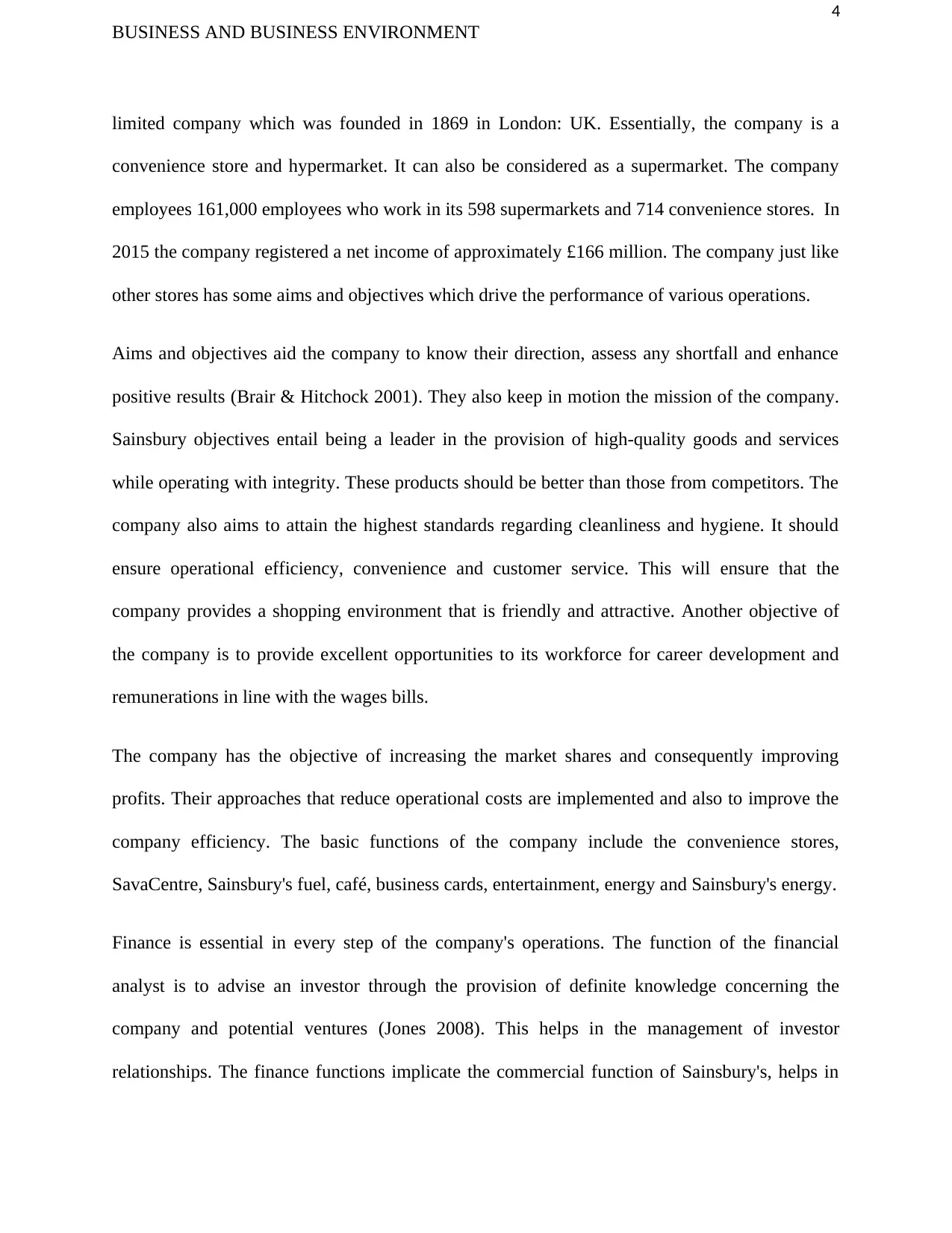
4
BUSINESS AND BUSINESS ENVIRONMENT
limited company which was founded in 1869 in London: UK. Essentially, the company is a
convenience store and hypermarket. It can also be considered as a supermarket. The company
employees 161,000 employees who work in its 598 supermarkets and 714 convenience stores. In
2015 the company registered a net income of approximately £166 million. The company just like
other stores has some aims and objectives which drive the performance of various operations.
Aims and objectives aid the company to know their direction, assess any shortfall and enhance
positive results (Brair & Hitchock 2001). They also keep in motion the mission of the company.
Sainsbury objectives entail being a leader in the provision of high-quality goods and services
while operating with integrity. These products should be better than those from competitors. The
company also aims to attain the highest standards regarding cleanliness and hygiene. It should
ensure operational efficiency, convenience and customer service. This will ensure that the
company provides a shopping environment that is friendly and attractive. Another objective of
the company is to provide excellent opportunities to its workforce for career development and
remunerations in line with the wages bills.
The company has the objective of increasing the market shares and consequently improving
profits. Their approaches that reduce operational costs are implemented and also to improve the
company efficiency. The basic functions of the company include the convenience stores,
SavaCentre, Sainsbury's fuel, café, business cards, entertainment, energy and Sainsbury's energy.
Finance is essential in every step of the company's operations. The function of the financial
analyst is to advise an investor through the provision of definite knowledge concerning the
company and potential ventures (Jones 2008). This helps in the management of investor
relationships. The finance functions implicate the commercial function of Sainsbury's, helps in
BUSINESS AND BUSINESS ENVIRONMENT
limited company which was founded in 1869 in London: UK. Essentially, the company is a
convenience store and hypermarket. It can also be considered as a supermarket. The company
employees 161,000 employees who work in its 598 supermarkets and 714 convenience stores. In
2015 the company registered a net income of approximately £166 million. The company just like
other stores has some aims and objectives which drive the performance of various operations.
Aims and objectives aid the company to know their direction, assess any shortfall and enhance
positive results (Brair & Hitchock 2001). They also keep in motion the mission of the company.
Sainsbury objectives entail being a leader in the provision of high-quality goods and services
while operating with integrity. These products should be better than those from competitors. The
company also aims to attain the highest standards regarding cleanliness and hygiene. It should
ensure operational efficiency, convenience and customer service. This will ensure that the
company provides a shopping environment that is friendly and attractive. Another objective of
the company is to provide excellent opportunities to its workforce for career development and
remunerations in line with the wages bills.
The company has the objective of increasing the market shares and consequently improving
profits. Their approaches that reduce operational costs are implemented and also to improve the
company efficiency. The basic functions of the company include the convenience stores,
SavaCentre, Sainsbury's fuel, café, business cards, entertainment, energy and Sainsbury's energy.
Finance is essential in every step of the company's operations. The function of the financial
analyst is to advise an investor through the provision of definite knowledge concerning the
company and potential ventures (Jones 2008). This helps in the management of investor
relationships. The finance functions implicate the commercial function of Sainsbury's, helps in
Paraphrase This Document
Need a fresh take? Get an instant paraphrase of this document with our AI Paraphraser
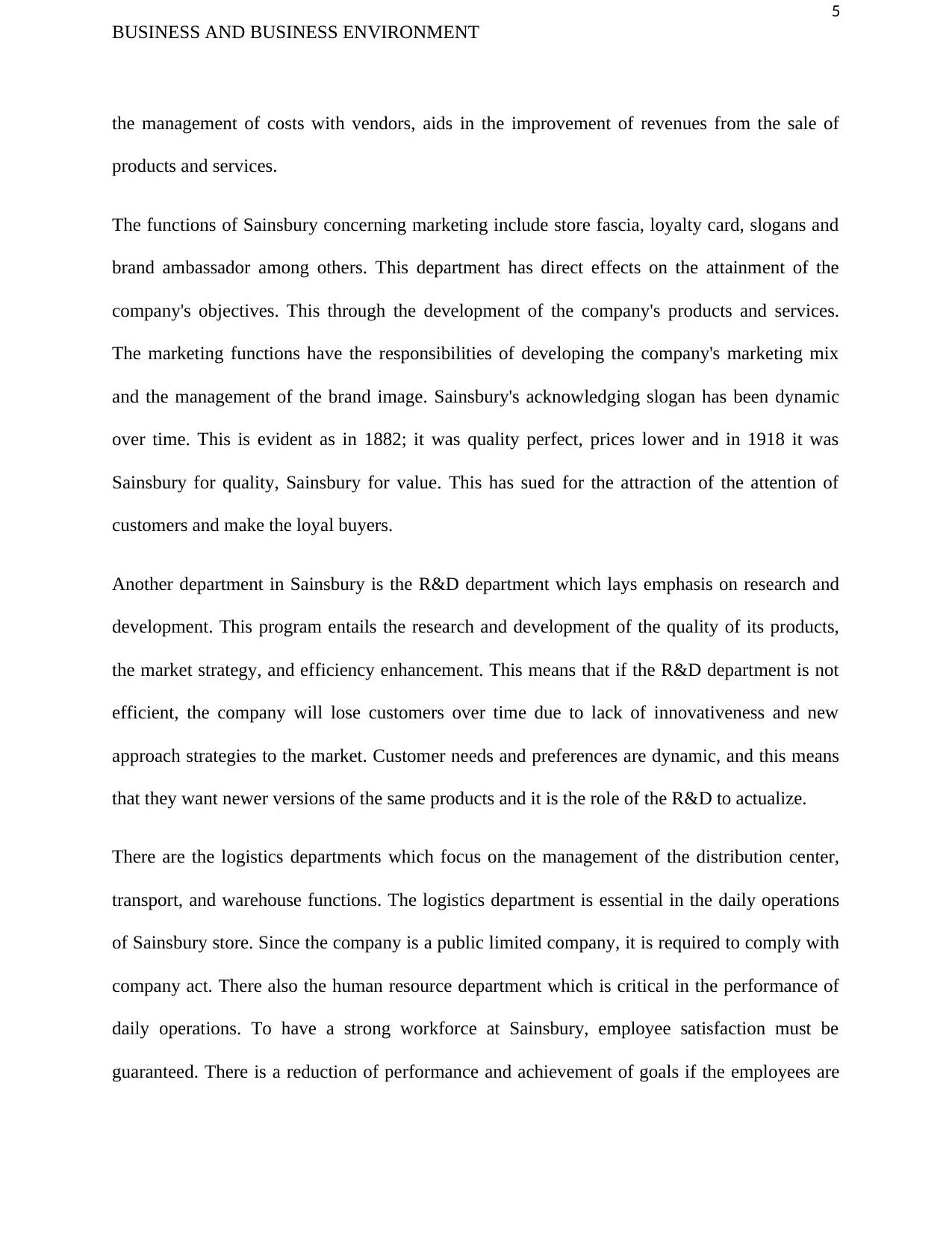
5
BUSINESS AND BUSINESS ENVIRONMENT
the management of costs with vendors, aids in the improvement of revenues from the sale of
products and services.
The functions of Sainsbury concerning marketing include store fascia, loyalty card, slogans and
brand ambassador among others. This department has direct effects on the attainment of the
company's objectives. This through the development of the company's products and services.
The marketing functions have the responsibilities of developing the company's marketing mix
and the management of the brand image. Sainsbury's acknowledging slogan has been dynamic
over time. This is evident as in 1882; it was quality perfect, prices lower and in 1918 it was
Sainsbury for quality, Sainsbury for value. This has sued for the attraction of the attention of
customers and make the loyal buyers.
Another department in Sainsbury is the R&D department which lays emphasis on research and
development. This program entails the research and development of the quality of its products,
the market strategy, and efficiency enhancement. This means that if the R&D department is not
efficient, the company will lose customers over time due to lack of innovativeness and new
approach strategies to the market. Customer needs and preferences are dynamic, and this means
that they want newer versions of the same products and it is the role of the R&D to actualize.
There are the logistics departments which focus on the management of the distribution center,
transport, and warehouse functions. The logistics department is essential in the daily operations
of Sainsbury store. Since the company is a public limited company, it is required to comply with
company act. There also the human resource department which is critical in the performance of
daily operations. To have a strong workforce at Sainsbury, employee satisfaction must be
guaranteed. There is a reduction of performance and achievement of goals if the employees are
BUSINESS AND BUSINESS ENVIRONMENT
the management of costs with vendors, aids in the improvement of revenues from the sale of
products and services.
The functions of Sainsbury concerning marketing include store fascia, loyalty card, slogans and
brand ambassador among others. This department has direct effects on the attainment of the
company's objectives. This through the development of the company's products and services.
The marketing functions have the responsibilities of developing the company's marketing mix
and the management of the brand image. Sainsbury's acknowledging slogan has been dynamic
over time. This is evident as in 1882; it was quality perfect, prices lower and in 1918 it was
Sainsbury for quality, Sainsbury for value. This has sued for the attraction of the attention of
customers and make the loyal buyers.
Another department in Sainsbury is the R&D department which lays emphasis on research and
development. This program entails the research and development of the quality of its products,
the market strategy, and efficiency enhancement. This means that if the R&D department is not
efficient, the company will lose customers over time due to lack of innovativeness and new
approach strategies to the market. Customer needs and preferences are dynamic, and this means
that they want newer versions of the same products and it is the role of the R&D to actualize.
There are the logistics departments which focus on the management of the distribution center,
transport, and warehouse functions. The logistics department is essential in the daily operations
of Sainsbury store. Since the company is a public limited company, it is required to comply with
company act. There also the human resource department which is critical in the performance of
daily operations. To have a strong workforce at Sainsbury, employee satisfaction must be
guaranteed. There is a reduction of performance and achievement of goals if the employees are
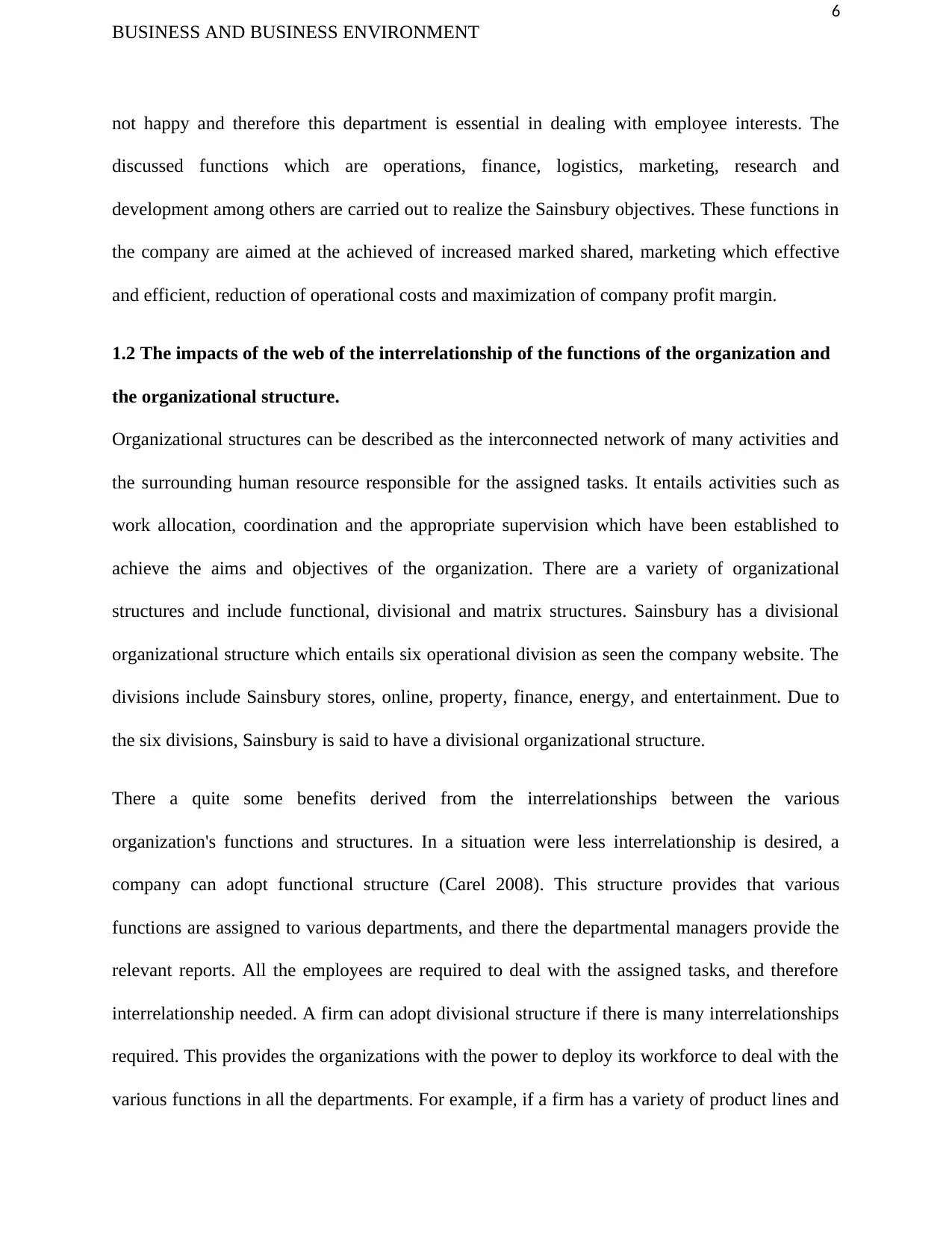
6
BUSINESS AND BUSINESS ENVIRONMENT
not happy and therefore this department is essential in dealing with employee interests. The
discussed functions which are operations, finance, logistics, marketing, research and
development among others are carried out to realize the Sainsbury objectives. These functions in
the company are aimed at the achieved of increased marked shared, marketing which effective
and efficient, reduction of operational costs and maximization of company profit margin.
1.2 The impacts of the web of the interrelationship of the functions of the organization and
the organizational structure.
Organizational structures can be described as the interconnected network of many activities and
the surrounding human resource responsible for the assigned tasks. It entails activities such as
work allocation, coordination and the appropriate supervision which have been established to
achieve the aims and objectives of the organization. There are a variety of organizational
structures and include functional, divisional and matrix structures. Sainsbury has a divisional
organizational structure which entails six operational division as seen the company website. The
divisions include Sainsbury stores, online, property, finance, energy, and entertainment. Due to
the six divisions, Sainsbury is said to have a divisional organizational structure.
There a quite some benefits derived from the interrelationships between the various
organization's functions and structures. In a situation were less interrelationship is desired, a
company can adopt functional structure (Carel 2008). This structure provides that various
functions are assigned to various departments, and there the departmental managers provide the
relevant reports. All the employees are required to deal with the assigned tasks, and therefore
interrelationship needed. A firm can adopt divisional structure if there is many interrelationships
required. This provides the organizations with the power to deploy its workforce to deal with the
various functions in all the departments. For example, if a firm has a variety of product lines and
BUSINESS AND BUSINESS ENVIRONMENT
not happy and therefore this department is essential in dealing with employee interests. The
discussed functions which are operations, finance, logistics, marketing, research and
development among others are carried out to realize the Sainsbury objectives. These functions in
the company are aimed at the achieved of increased marked shared, marketing which effective
and efficient, reduction of operational costs and maximization of company profit margin.
1.2 The impacts of the web of the interrelationship of the functions of the organization and
the organizational structure.
Organizational structures can be described as the interconnected network of many activities and
the surrounding human resource responsible for the assigned tasks. It entails activities such as
work allocation, coordination and the appropriate supervision which have been established to
achieve the aims and objectives of the organization. There are a variety of organizational
structures and include functional, divisional and matrix structures. Sainsbury has a divisional
organizational structure which entails six operational division as seen the company website. The
divisions include Sainsbury stores, online, property, finance, energy, and entertainment. Due to
the six divisions, Sainsbury is said to have a divisional organizational structure.
There a quite some benefits derived from the interrelationships between the various
organization's functions and structures. In a situation were less interrelationship is desired, a
company can adopt functional structure (Carel 2008). This structure provides that various
functions are assigned to various departments, and there the departmental managers provide the
relevant reports. All the employees are required to deal with the assigned tasks, and therefore
interrelationship needed. A firm can adopt divisional structure if there is many interrelationships
required. This provides the organizations with the power to deploy its workforce to deal with the
various functions in all the departments. For example, if a firm has a variety of product lines and
⊘ This is a preview!⊘
Do you want full access?
Subscribe today to unlock all pages.

Trusted by 1+ million students worldwide

7
BUSINESS AND BUSINESS ENVIRONMENT
adopts the divisional structure. This means that the organization needs to have marketing, R&D,
sales and accounting among other departments for each product. The high interrelationship and
teamwork are desired, then the company should consider implementing the matrix structure.
There are both pros and cons of the interrelationship of functions and the structure of the
organization. Interrelationship promotes the sharing of skills, experience among the employees
and this is beneficial to the organization in the long term. This means that the organization can
recruit employees from diverse origins, culture, and ethnicity. It aids the company in the
development of diversity in the workplace which fosters an environment of sharing skills and
experience. It is not always possible gathers are the requirements, but the provision of a friendly
working environment helps in realizing the full potential of the employees. The interrelationship
helps in the proper function of the operations and timely achievement of the goals. Despite the
above benefits, there some shortcomings which include a slower process of decision making.
This is so since the organization has to perform two aspects of the interrelationships in the
process if its adoption.
Part 2: Critically assessing Sainsbury's.
2.1 The implications of macro and micro factors
2.1.1 The identification of the positive and negative effects of the macro-environment on the
Sainsbury's business activities.
Macroeconomic factors have a profound effect on the operations undertaken by any firm. These
factors usually include economic, political, environmental and technological. There are both the
benefits and shortcomings of these factors on the business operations of Sainsbury.
Economic Factors
BUSINESS AND BUSINESS ENVIRONMENT
adopts the divisional structure. This means that the organization needs to have marketing, R&D,
sales and accounting among other departments for each product. The high interrelationship and
teamwork are desired, then the company should consider implementing the matrix structure.
There are both pros and cons of the interrelationship of functions and the structure of the
organization. Interrelationship promotes the sharing of skills, experience among the employees
and this is beneficial to the organization in the long term. This means that the organization can
recruit employees from diverse origins, culture, and ethnicity. It aids the company in the
development of diversity in the workplace which fosters an environment of sharing skills and
experience. It is not always possible gathers are the requirements, but the provision of a friendly
working environment helps in realizing the full potential of the employees. The interrelationship
helps in the proper function of the operations and timely achievement of the goals. Despite the
above benefits, there some shortcomings which include a slower process of decision making.
This is so since the organization has to perform two aspects of the interrelationships in the
process if its adoption.
Part 2: Critically assessing Sainsbury's.
2.1 The implications of macro and micro factors
2.1.1 The identification of the positive and negative effects of the macro-environment on the
Sainsbury's business activities.
Macroeconomic factors have a profound effect on the operations undertaken by any firm. These
factors usually include economic, political, environmental and technological. There are both the
benefits and shortcomings of these factors on the business operations of Sainsbury.
Economic Factors
Paraphrase This Document
Need a fresh take? Get an instant paraphrase of this document with our AI Paraphraser

8
BUSINESS AND BUSINESS ENVIRONMENT
These are the factors that impact on the purchasing power and spending of the customers in an
economy. They include GDP, GNI, sales tax, unemployment inflation and GDP real growth rate.
Another important issue is the disposable personal income. In the case of immense growth in the
economy, there will be positive impacts on the level of sales for Sainsbury since the income of
the consumers will have improved. On the other hand, increase in inflation will lead increase in
the cost of raw materials leading to high product prices.
Political Factors
These factors have a great effect on the operation of an organization. Political factors entail the
degree of government interference in the business operations. They include factors such as legal
issues, rules from the governments and other relevant regulations that affect the policies and
procedures in the organization (Regoff & Bezos 2007). There are new challenges and
opportunities in the retail market brought about by the concept of globalization. Since Sainsbury
is a retail store, globalization has brought about opportunities such as joint ventures and
partnerships in the emerging markets, especially in the developing nations. Also, the UK
government has reduced the corporate tax by 2% from 30% to 28% which has helped the
retailing business to make the investment with the excess money.
Technological Factors
When technology has utilized the rate of growth of production increase. The development is both
in quantity and quality, and therefore technology has affected the operations ate Sainsbury. The
company will be to adopt the trending technology and integrate it into the business. Failure to do
this, the production of goods and services would be outdated making the company lose market
BUSINESS AND BUSINESS ENVIRONMENT
These are the factors that impact on the purchasing power and spending of the customers in an
economy. They include GDP, GNI, sales tax, unemployment inflation and GDP real growth rate.
Another important issue is the disposable personal income. In the case of immense growth in the
economy, there will be positive impacts on the level of sales for Sainsbury since the income of
the consumers will have improved. On the other hand, increase in inflation will lead increase in
the cost of raw materials leading to high product prices.
Political Factors
These factors have a great effect on the operation of an organization. Political factors entail the
degree of government interference in the business operations. They include factors such as legal
issues, rules from the governments and other relevant regulations that affect the policies and
procedures in the organization (Regoff & Bezos 2007). There are new challenges and
opportunities in the retail market brought about by the concept of globalization. Since Sainsbury
is a retail store, globalization has brought about opportunities such as joint ventures and
partnerships in the emerging markets, especially in the developing nations. Also, the UK
government has reduced the corporate tax by 2% from 30% to 28% which has helped the
retailing business to make the investment with the excess money.
Technological Factors
When technology has utilized the rate of growth of production increase. The development is both
in quantity and quality, and therefore technology has affected the operations ate Sainsbury. The
company will be to adopt the trending technology and integrate it into the business. Failure to do
this, the production of goods and services would be outdated making the company lose market
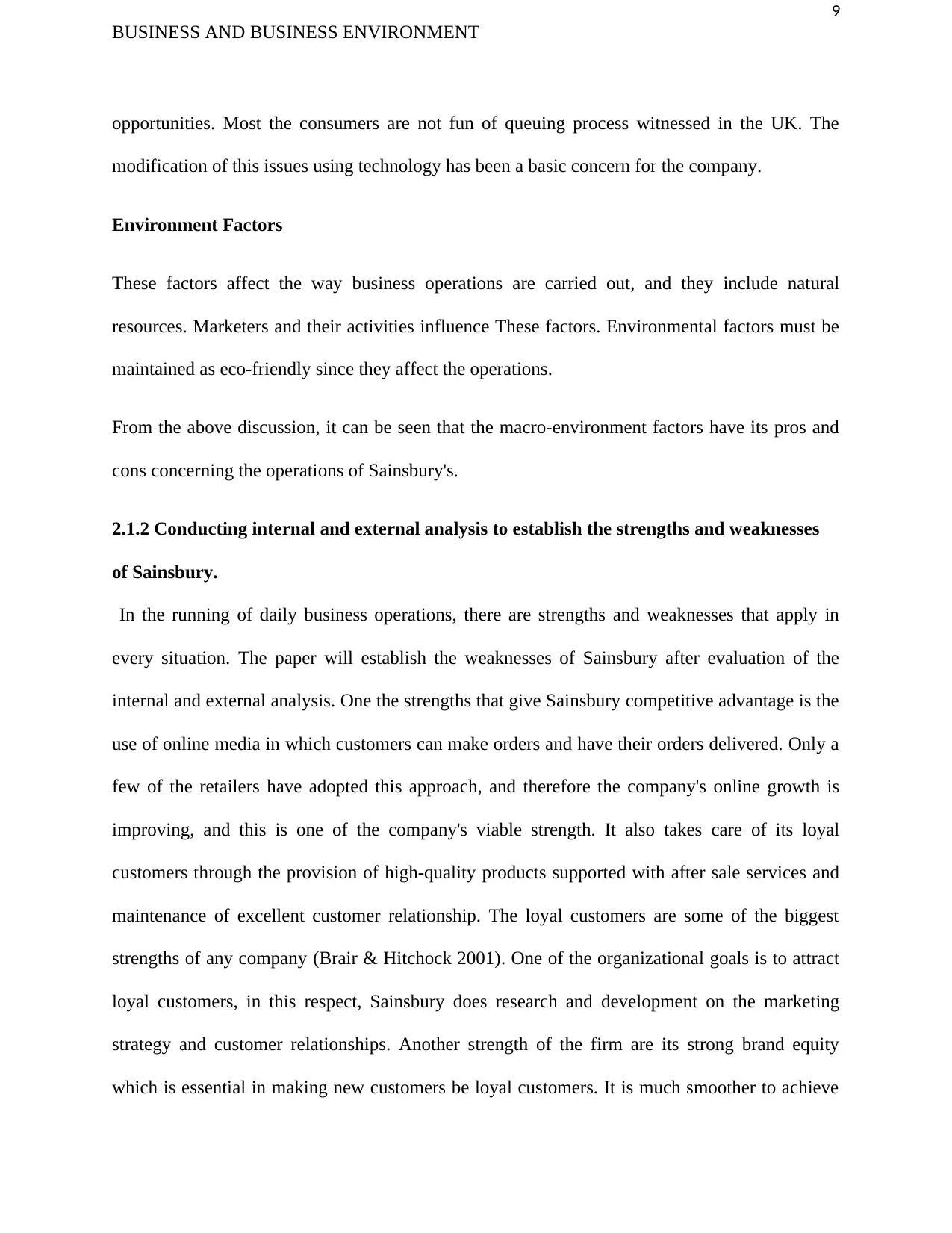
9
BUSINESS AND BUSINESS ENVIRONMENT
opportunities. Most the consumers are not fun of queuing process witnessed in the UK. The
modification of this issues using technology has been a basic concern for the company.
Environment Factors
These factors affect the way business operations are carried out, and they include natural
resources. Marketers and their activities influence These factors. Environmental factors must be
maintained as eco-friendly since they affect the operations.
From the above discussion, it can be seen that the macro-environment factors have its pros and
cons concerning the operations of Sainsbury's.
2.1.2 Conducting internal and external analysis to establish the strengths and weaknesses
of Sainsbury.
In the running of daily business operations, there are strengths and weaknesses that apply in
every situation. The paper will establish the weaknesses of Sainsbury after evaluation of the
internal and external analysis. One the strengths that give Sainsbury competitive advantage is the
use of online media in which customers can make orders and have their orders delivered. Only a
few of the retailers have adopted this approach, and therefore the company's online growth is
improving, and this is one of the company's viable strength. It also takes care of its loyal
customers through the provision of high-quality products supported with after sale services and
maintenance of excellent customer relationship. The loyal customers are some of the biggest
strengths of any company (Brair & Hitchock 2001). One of the organizational goals is to attract
loyal customers, in this respect, Sainsbury does research and development on the marketing
strategy and customer relationships. Another strength of the firm are its strong brand equity
which is essential in making new customers be loyal customers. It is much smoother to achieve
BUSINESS AND BUSINESS ENVIRONMENT
opportunities. Most the consumers are not fun of queuing process witnessed in the UK. The
modification of this issues using technology has been a basic concern for the company.
Environment Factors
These factors affect the way business operations are carried out, and they include natural
resources. Marketers and their activities influence These factors. Environmental factors must be
maintained as eco-friendly since they affect the operations.
From the above discussion, it can be seen that the macro-environment factors have its pros and
cons concerning the operations of Sainsbury's.
2.1.2 Conducting internal and external analysis to establish the strengths and weaknesses
of Sainsbury.
In the running of daily business operations, there are strengths and weaknesses that apply in
every situation. The paper will establish the weaknesses of Sainsbury after evaluation of the
internal and external analysis. One the strengths that give Sainsbury competitive advantage is the
use of online media in which customers can make orders and have their orders delivered. Only a
few of the retailers have adopted this approach, and therefore the company's online growth is
improving, and this is one of the company's viable strength. It also takes care of its loyal
customers through the provision of high-quality products supported with after sale services and
maintenance of excellent customer relationship. The loyal customers are some of the biggest
strengths of any company (Brair & Hitchock 2001). One of the organizational goals is to attract
loyal customers, in this respect, Sainsbury does research and development on the marketing
strategy and customer relationships. Another strength of the firm are its strong brand equity
which is essential in making new customers be loyal customers. It is much smoother to achieve
⊘ This is a preview!⊘
Do you want full access?
Subscribe today to unlock all pages.

Trusted by 1+ million students worldwide
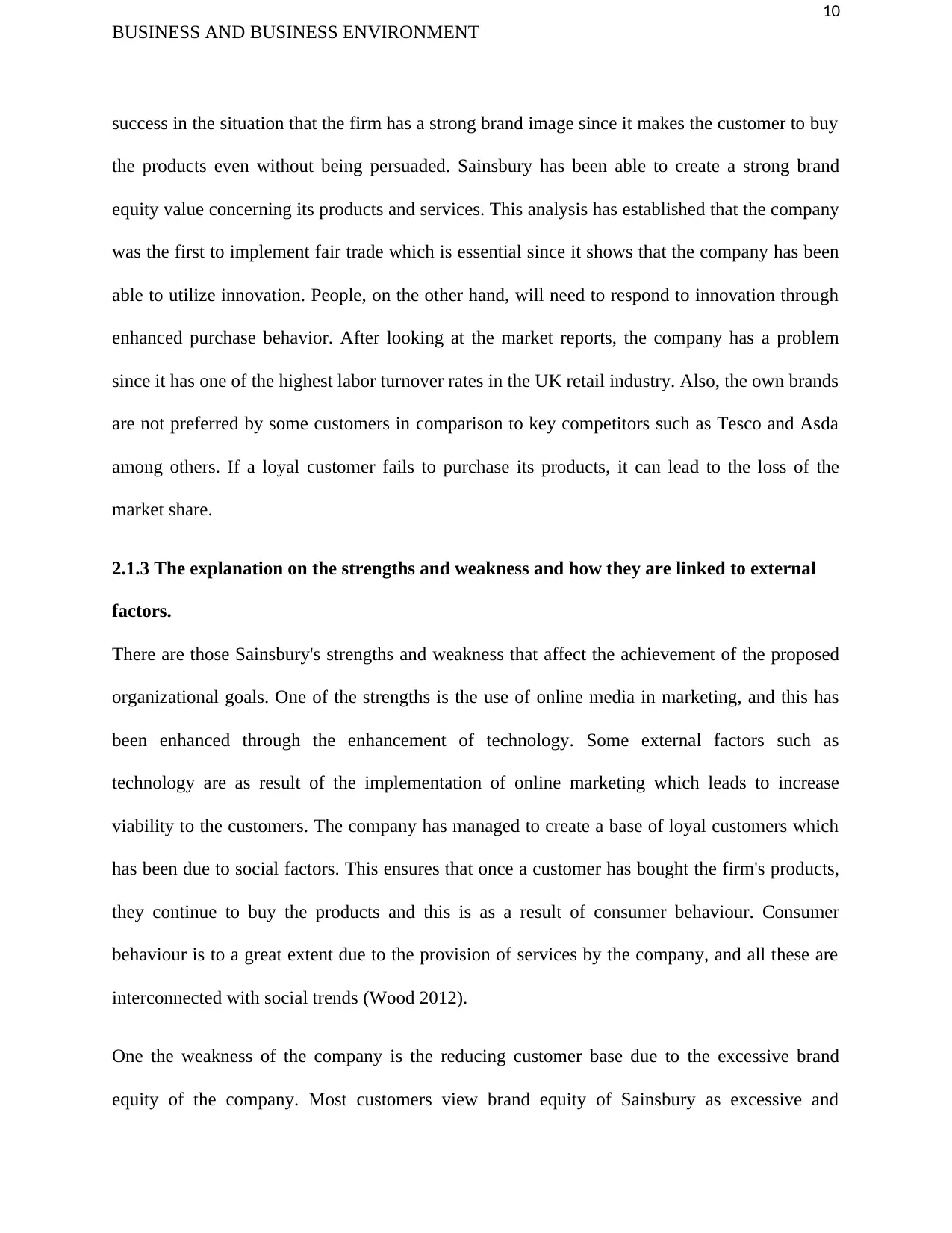
10
BUSINESS AND BUSINESS ENVIRONMENT
success in the situation that the firm has a strong brand image since it makes the customer to buy
the products even without being persuaded. Sainsbury has been able to create a strong brand
equity value concerning its products and services. This analysis has established that the company
was the first to implement fair trade which is essential since it shows that the company has been
able to utilize innovation. People, on the other hand, will need to respond to innovation through
enhanced purchase behavior. After looking at the market reports, the company has a problem
since it has one of the highest labor turnover rates in the UK retail industry. Also, the own brands
are not preferred by some customers in comparison to key competitors such as Tesco and Asda
among others. If a loyal customer fails to purchase its products, it can lead to the loss of the
market share.
2.1.3 The explanation on the strengths and weakness and how they are linked to external
factors.
There are those Sainsbury's strengths and weakness that affect the achievement of the proposed
organizational goals. One of the strengths is the use of online media in marketing, and this has
been enhanced through the enhancement of technology. Some external factors such as
technology are as result of the implementation of online marketing which leads to increase
viability to the customers. The company has managed to create a base of loyal customers which
has been due to social factors. This ensures that once a customer has bought the firm's products,
they continue to buy the products and this is as a result of consumer behaviour. Consumer
behaviour is to a great extent due to the provision of services by the company, and all these are
interconnected with social trends (Wood 2012).
One the weakness of the company is the reducing customer base due to the excessive brand
equity of the company. Most customers view brand equity of Sainsbury as excessive and
BUSINESS AND BUSINESS ENVIRONMENT
success in the situation that the firm has a strong brand image since it makes the customer to buy
the products even without being persuaded. Sainsbury has been able to create a strong brand
equity value concerning its products and services. This analysis has established that the company
was the first to implement fair trade which is essential since it shows that the company has been
able to utilize innovation. People, on the other hand, will need to respond to innovation through
enhanced purchase behavior. After looking at the market reports, the company has a problem
since it has one of the highest labor turnover rates in the UK retail industry. Also, the own brands
are not preferred by some customers in comparison to key competitors such as Tesco and Asda
among others. If a loyal customer fails to purchase its products, it can lead to the loss of the
market share.
2.1.3 The explanation on the strengths and weakness and how they are linked to external
factors.
There are those Sainsbury's strengths and weakness that affect the achievement of the proposed
organizational goals. One of the strengths is the use of online media in marketing, and this has
been enhanced through the enhancement of technology. Some external factors such as
technology are as result of the implementation of online marketing which leads to increase
viability to the customers. The company has managed to create a base of loyal customers which
has been due to social factors. This ensures that once a customer has bought the firm's products,
they continue to buy the products and this is as a result of consumer behaviour. Consumer
behaviour is to a great extent due to the provision of services by the company, and all these are
interconnected with social trends (Wood 2012).
One the weakness of the company is the reducing customer base due to the excessive brand
equity of the company. Most customers view brand equity of Sainsbury as excessive and
Paraphrase This Document
Need a fresh take? Get an instant paraphrase of this document with our AI Paraphraser

11
BUSINESS AND BUSINESS ENVIRONMENT
therefore do not like to afford to buy their products. This is contributed by the dynamic social
trends and customer preference. In the situation that the social trend change, the purchasing of
the company products might change and this lead to implications on the growth prospects. The
customer's habit is a factor to be considered for their choice of the product. If the customers are
not able to maintain their behaviour of purchasing branded goods from Sainsbury, the company
will lose its customer bases. The base of loyal customers and the strong brand equity are
perceived as the company strengths. This has been contributed to by the external factors such as
the economic aspect of the community. Other economic factors in action include improvement in
the disposable income, inflation, unemployment among others.
When the disposable income increases, the purchasing power of the consumers is enhanced, and
this makes the customers to purchase products provided by Sainsbury, and this increases the
possibility of making them loyal customers. In the situation that inflation increases, the cost of
production increases leading to high product prices and this means that inflation has negative
implications. The company has been exploring new areas since it is inclined to availing new
services to customers. The company objective is to improve the value bases customer which
beneficial when they respond with purchasing behavior which is interconnected with economic
factors.
It can, therefore, be concluded that the firm's strengths and weaknesses are linked with various
external aspects such as technology, economic, and social among others.
2.1.4 Evaluation of the Sainsbury PESTEL and SWOT analysis.
Sainsbury's PESTLE and SWOT analysis will help in the evaluation of its business environment
together with its strengths and weakness in a detailed aspect.
BUSINESS AND BUSINESS ENVIRONMENT
therefore do not like to afford to buy their products. This is contributed by the dynamic social
trends and customer preference. In the situation that the social trend change, the purchasing of
the company products might change and this lead to implications on the growth prospects. The
customer's habit is a factor to be considered for their choice of the product. If the customers are
not able to maintain their behaviour of purchasing branded goods from Sainsbury, the company
will lose its customer bases. The base of loyal customers and the strong brand equity are
perceived as the company strengths. This has been contributed to by the external factors such as
the economic aspect of the community. Other economic factors in action include improvement in
the disposable income, inflation, unemployment among others.
When the disposable income increases, the purchasing power of the consumers is enhanced, and
this makes the customers to purchase products provided by Sainsbury, and this increases the
possibility of making them loyal customers. In the situation that inflation increases, the cost of
production increases leading to high product prices and this means that inflation has negative
implications. The company has been exploring new areas since it is inclined to availing new
services to customers. The company objective is to improve the value bases customer which
beneficial when they respond with purchasing behavior which is interconnected with economic
factors.
It can, therefore, be concluded that the firm's strengths and weaknesses are linked with various
external aspects such as technology, economic, and social among others.
2.1.4 Evaluation of the Sainsbury PESTEL and SWOT analysis.
Sainsbury's PESTLE and SWOT analysis will help in the evaluation of its business environment
together with its strengths and weakness in a detailed aspect.

12
BUSINESS AND BUSINESS ENVIRONMENT
Sainsbury's PESTLE Analysis
Political Factors
The company is based in the UK and this means that the political state of the company has
implications on the operation and performance. The rate is high concerning the government's and
consumer's debts. It affects the attitudes of the customer and business operations. Despite the
state of the political climate, it is essential for the company to remain competitive.
Economic Factors
When there is a recession, Sainsbury's business operation are affected due to the increment in
inflation and unemployment. These are the two major economic factors. When there is high
inflation, the demand of products is reduced. The increase in unemployment reduces the
customers' purchasing power. Concerning these two factors, the company needs to develop its
business operations in the developing markets.
Social Factors
Currently, the customer behaviour of customers is that the want convenience. This means that
they do not want to move around looking for different products, but they want to get products in
one place (Information Age: 2004). Sainsbury has ensured to utilize this opportunity by
providing all products in one location. The increase in female working staff has resulted into
reduced home cooking, and this means there are changes in the demand pattern.
Technological Factors
BUSINESS AND BUSINESS ENVIRONMENT
Sainsbury's PESTLE Analysis
Political Factors
The company is based in the UK and this means that the political state of the company has
implications on the operation and performance. The rate is high concerning the government's and
consumer's debts. It affects the attitudes of the customer and business operations. Despite the
state of the political climate, it is essential for the company to remain competitive.
Economic Factors
When there is a recession, Sainsbury's business operation are affected due to the increment in
inflation and unemployment. These are the two major economic factors. When there is high
inflation, the demand of products is reduced. The increase in unemployment reduces the
customers' purchasing power. Concerning these two factors, the company needs to develop its
business operations in the developing markets.
Social Factors
Currently, the customer behaviour of customers is that the want convenience. This means that
they do not want to move around looking for different products, but they want to get products in
one place (Information Age: 2004). Sainsbury has ensured to utilize this opportunity by
providing all products in one location. The increase in female working staff has resulted into
reduced home cooking, and this means there are changes in the demand pattern.
Technological Factors
⊘ This is a preview!⊘
Do you want full access?
Subscribe today to unlock all pages.

Trusted by 1+ million students worldwide
1 out of 19
Related Documents
Your All-in-One AI-Powered Toolkit for Academic Success.
+13062052269
info@desklib.com
Available 24*7 on WhatsApp / Email
![[object Object]](/_next/static/media/star-bottom.7253800d.svg)
Unlock your academic potential
Copyright © 2020–2025 A2Z Services. All Rights Reserved. Developed and managed by ZUCOL.




